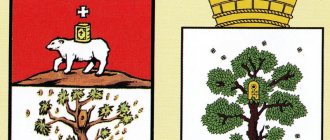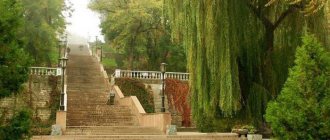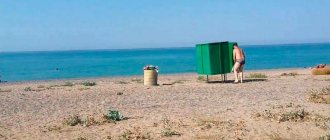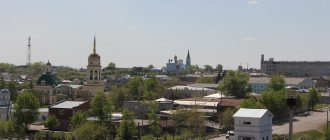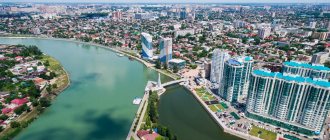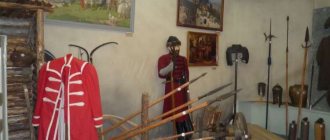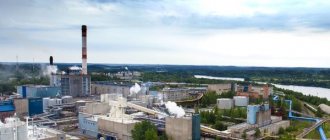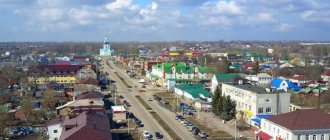The city, among many of the same, whose history is connected with mining and metallurgy, is fourth in population in the Middle Urals after Kamensk-Uralsky, Nizhny Tagil and, of course, Yekaterinburg. The city, which back in 1920 was called the Vasilyevo-Shaitansky village, and which later became a large cultural and industrial center of the Urals, is Pervouralsk.
Pervouralsk is located between the mountain peaks of the Ural ridge on the banks of the local Shaitanka River, on which two city ponds are formed by dams: Nizhny and Verkhniy.
The Elnichnaya river, on which there is also a pond, Malaya Shaitanka, and other small and large rivers flow through Pervouralsk.
But the most interesting among them is the Chusovaya River, with its rich history, which you can familiarize yourself with here.
Pervouralsk: attractions and interesting places
Pervouralsk is a city in the Sverdlovsk region, a large industrial and cultural center of the region.
The date of foundation is considered to be December 1, 1732, the day when the blast furnace of the ironworks produced the first cast iron. True, at that time it was not yet a city, but a village near a factory and it was called Vasilyevsko-Shaitansk. The settlement received its current name only in 1920. The city stands on a large water artery of the Ural region, the Chusovaya River, along which at one time the famous iron caravan, barges loaded with millions of pounds of cast iron, iron and products made from them, walked.
Sights of Pervouralsk
Pervouralsk owes its birth to the discovery of an iron ore deposit near Mount Volchaya (Volchikha) in 1702. In the summer of 1730, Nikita Demidov’s grandson, Vasily, began construction of a plant on the Shaitanka River. The river was “closed” with a one hundred and twenty fathom dam. Behind it stood factory buildings: a blast furnace, a fur and fur factory, a forge. On December 1, 1732, the first cast iron was smelted at the plant.
This is what the dam looked like. The body of the dam is made of larch and has not been rebuilt since its construction. It’s logical to start your city tour from here. This is what the dam looks like now.
The old photograph clearly shows the Temple in the name of the Holy Apostles Peter and Paul. The first wooden church was consecrated in 1752; it stood near the Moscow highway; there were 5 bells on the belfry. In the summer of 1821, a fire raged in the village and the church burned down. Instead, in 1822, the construction of a new temple was completed.
In 1930, the temple was closed, and at different times there were in this building a cinema, a local history museum, a weight repair shop, and a sausage factory. Then the building was blown up. Since 1990, the Temple has been revived, and the ringing of bells again floats over the city.
From the old dam you need to walk along the embankment, lined with slabs, to the bend. At the turn of the road, a two-story wooden house has been preserved. By its location you can determine where the main street, Lenin Street, was located. It housed administrative buildings, a bank, a bookstore, etc. The Moscow Highway passed along this street. While landscaping the area near another high-rise building (a yellow house on the shore of a pond), a part of old paving stones was found.
On the wide alley of Vatutina Street is a traditional gathering place for veterans of all branches of the military. From this place a wide staircase leads up to the current city center. At the very top you can see the Palace of Culture of the Novotrubny Plant.
We go up the steps, sometimes we stop to rest, and turn around!
Here we are on the square near the NTZ Department of Culture and Culture. The palace itself was built in 1969; its model was exhibited at the World Exhibition in Montreal. Magnificent mosaic panels on the facade symbolize work, creativity, science, creation.
Next to the palace is the Central City Library, with an excellent local history department. There are always exhibitions in the library - check it out, you won’t regret it! In summer there is a fountain. During the daytime, the square is full of mothers and grandmothers walking with their children; in the evening, it is a favorite place for young people.
The central square of the city is Victory Square. Naturally, a monument to Lenin. The city administration building, a once gray three-story building, is now decorated with “chimes” and illuminated at night.
This is where we begin our architectural journey. Before us is that part of Vatutina Street, which was built in the 50s of the 20th century. The houses are three-story, cinder block, decorated with stucco elements typical of classical architecture. The year of construction is sculpted on some houses.
Let's walk a block along Vatutina Street to the intersection with Herzen Street and turn right, walk between houses with turrets, walk one block and end up in the Park of Culture and Leisure. It’s worth a look - an island of real forest almost in the center of the city! Convenient playgrounds, benches, swings, attractions...
The mini-zoo in the park deserves attention; a ticket costs only 60 rubles, and you will get a lot of pleasure from interacting with the animals. You can see Altai deer, mouflons, camels, wolves, foxes, noses and almost all domestic animals - sheep, goats, ducks, geese, chickens, turkeys and many others. Among the exotic ones are ostriches.
If you're lucky, you can feed the squirrels; they are loved, protected, and pampered in the park...
After a walk in the park, we go back along Herzen Street, cross the already familiar Vatutina Street and immediately turn left into the courtyards. Once upon a time, the courtyards had flower beds, gazebos, fountains, cast fences... And now we find ourselves in a 1957 construction area. It was from here that the construction of large-panel residential buildings began. On one of them there is a sign: “The first panel residential building in Pervouralsk. Commissioned in May 1958." Living history!
And here is the house itself.
This birch grove was lovingly planted by the residents. How carefully the townspeople treated the new areas, how lovingly they equipped them!
We go further, we go out onto Chkalov Street. This yellow house houses the Metallurg cafe and the Assol snack bar - you can refresh yourself.
This is the area of the first multi-storey brick houses, construction of the 30s and 40s, as stated on the sign on the house at Herzen 7.
The next intersection takes us to Trubnikov Street. It is easy to recognize - one side of the street is made up of two-story houses, the other - five-story ones. Behind these five-story buildings is the Ship Grove. All that remained was the name - ship grade pine trees were straight, tall pine trees, without flaws, which were suitable for making ship masts. They gave the name to the area. Paradox - the birch grove is called Korabelnaya. This street arose along the road to neighboring Revda.
At the end of the street we see the only surviving wooden cottage. There were several such cottages on Shkolnaya, Volodarskogo, Papanintsev streets; in the courtyards there were cozy squares, sculptures, and fountains. There are still photographs of the “Elephant” fountain. The rotunda has survived to this day, although not in the best condition.
Then we move past the mosque and find ourselves in the village of the chrome peak plant. The history of the village begins in 1915; it was built next to the plant. The center of the village is the Lenin Club with a park and stadium. In the village there are monuments to Julius Fuchek and General Karbyshev.
Through the village we go to the railway station. From here you can go to Yekaterinburg. But it’s interesting to see another monument; not all Pervouralsk residents know about its existence. The memorial complex to the heroes of the Civil and Great Patriotic Wars was installed on the square near the plant management of JSC Khrompik. To see it you need to cross the railway pedestrian bridge.
Our little journey has come to an end. This article contains only a small corner of the city. I suggest you just come and see!
Innovation cultural center
The construction of the ICC took place with money from the federal budget, lasted three years, and was completed in 2021. Due to its unusual shape, the building was nicknamed the “innovative puck” and indeed it resembles this sports equipment. The building attracts attention, especially at night, as the unusual kinetic façade glows in the dark.
Within the walls of the ICC there are: a museum of mining civilization; design and invention laboratory; studio-museum of animation, occupies two whole floors; cinema. Exhibitions, concerts, festivals, competitions, educational and social events, city holidays and even sports competitions are regularly held here.
Ski resort "Mount Pilnaya"
There was once a sawmill on the mountain from this fact, and the name Pilnaya came about. Currently, the mountain is located within the city limits. There are four ski slopes on its slopes, with a total length of almost three kilometers, with a maximum elevation difference of 100 meters.
For comfortable skiing, the resort has a convenient infrastructure. There are two modern lifts; cafes and rentals where you can rent skis or snowboards, as well as everything you need for skiing. For visitors who come with children, there is a children's room and a children's skating school. At night, the track is illuminated, which creates a special atmosphere when skiing.
Sports tourism in Pervouralsk and its surroundings
Winter sports are very popular in Pervouralsk, but in the summer, active recreation enthusiasts will have something to keep their muscles busy.
Mount Volchikha
- Coordinates on the map: 56.824332, 59.995587.
Volchikha is the highest mountain in the Yekaterinburg environs (526.3 m). It got its name from the fact that in the 18th century a large number of wolves lived in its forests, but today this place is safe for tourists.
In the summer, climbers come here. The rocky slopes of the mountain are used as a natural climbing wall. And in winter, the mountain is “captured” by skiers and snowboarders. During the snowy season, a funicular starts running on Volchikha, and ski slopes of different difficulty levels open.
Stela Europe – Asia
Not far from the city on the slope of Mount Berezovaya, there is the highest point of the Siberian Highway. Here, back in 1837, a memorial sign Europe - Asia was installed, it was installed specifically for the arrival of Alexander II, who traveled here with the poet Vasily Andreevich Zhukovsky.
Initially, the monument was wooden in the shape of a pyramid, and later it was replaced by a majestic stone stele with a double-headed eagle at the top. During the Civil War, the monument, crowned with the symbol of royal power, was destroyed. The Soviet authorities also erected a stone memorial sign, much more modest than in Tsarist times. Now it has been moved a little lower to the water source. The monument acquired its modern appearance in 2008. Now it is a stele made of red granite, screwed on, as in pre-revolutionary years, with a double-headed eagle.
People's House
The only architectural monument of the 19th century in Pervouralsk. The exact date of construction of the house is unknown. The building was once part of a city estate, which, in addition to the main house, also included a barn, a massive gate and several outbuildings.
To this day, only the main house of the estate has survived. This is a two-story building, built in the traditional style of the 19th century, the first floor is brick, the second is wooden. The house is decorated with numerous carved elements. Folk festivals, music and folklore events are held here.
Palace of Culture "Fireproofer"
The building of the Palace of Culture was built in 1956. The facade of the Palace of Culture and its architecture have not undergone major changes since then. Which is not typical for other urban buildings of that period of history. This makes the Palace of Culture a unique building in Pervouralsk, where there is not much that reminds us of the city's long history. The Ogneuporshchik cultural center has a hall for 600 seats . Various concerts, festivals, and other public events are often held here.
Park of New Culture
The city park is a popular recreation spot among citizens. On its territory there are a large number of attractions: a Ferris wheel, an autodrome, a cave of fears, a shooting gallery and many different carousels. The rope town “Beehive” is located in the trees.
In the winter season, ice banana rides are organized. There is also a mini-zoo, which contains: foxes, wolves, deer, ostriches, camels, various species of birds and the pride of the zoo, the brown bear Baloo. The Husky Park occupies a special place; here you can get to know the dogs of this wonderful breed or just ride in a dog sled.
Location: Fizkulturnikov street.
What is Pervouralsk like?
In the center of the Eurasian continent is the city of Pervouralsk, Sverdlovsk region. The distance to Yekaterinburg (regional center) is 40 km, and to Moscow – 1627 km. The population is about 124 thousand people.
The territory was formed in a gorge between the mountains. Near the city's border lies the dividing line between Asia and Europe.
The main enterprises of the city: Pervouralsk Novotrubny, Pervouralsk City Dairy, Pervouralsk Dinas Plant and many others.
Pervouralsk is a connecting point of the Trans-Siberian Railway, connecting Yekaterinburg, St. Petersburg, Perm and Moscow.
Brief historical background
The life of Pervouralsk began back in the 18th century, when iron ore deposits were discovered by ore explorer Fyodor Utkin. The settlement did not appear immediately, but only 20 years later and was called the village of Podvoloshnaya.
In 1732, on December 1, the first local factory produced a batch of cast iron. Historically, it was this number that began to be considered the founding date.
During the 18-19 centuries, the area around the settlement was actively explored, several factories were opened, for example, the Chrompikovsky plant, the Shaitansky chemical plant, the Verkh-Isetsky plant and others.
By the beginning of the 20th century, the village of Podvoloshnaya had already changed its name several times and in 1933 became the city of Pervouralsk.
Until today, the city is the largest industrial center of the Urals, its culture and attractions are developing. Pervouralsk becomes more beautiful and interesting every year. There's always something new coming up.
Sights of the city of Pervouralsk: monuments and sculptures
The monument to D. M. Karbyshev, on Karbysheva Street, 2, was erected in 1968. The author is V. E. Egorov. The sculpture is considered one of several dedicated to the events of the war and its heroes. Dmitry Mikhailovich - went through 4 wars, was posthumously awarded the Title of Hero of the Soviet Union and Knight of the Order of Lenin. Streets, educational institutions and organizations throughout the country are named in his honor.
The main attraction of Pervouralsk is the “Europe-Asia” obelisk. The official border between the two constituent parts of the continent runs through the Ural Mountains. In some places there are special obelisks symbolizing division. In Pervouralsk, on Mount Berezovaya there is one of them. Its history began back in 1837, then it was made of wood, more like a pyramid. In 1873, the pillar was replaced with a marble obelisk mounted on a pedestal. The last reconstruction took place in 2008.
Monument to the first Ural residents who died in local conflicts in the park on Vatutina Street in 2002. The initiative to create it arose from members of the organization of Afghans who suffered in the conflict. Their idea was supported by city enterprises. The composition is an infantry fighting vehicle located on a special pedestal.
Monument to Unity of Front and Rear
20 years after the victory in the Great Patriotic War, workers of the Novotrubny Plant took the initiative to erect a monument to the Unity of the front and rear. A memorial stone was laid with an inscription notifying that there would soon be a monument here. However, as often happens, financial problems prevented this plan from being realized.
As a result, the townspeople took matters into their own hands and built the monument with their own money. The opening ceremony of the monument took place in September 1968. The monument is a sculptural image of a warrior kneeling and a worker standing at the banner. Initially, the monument was gray, but in 2013 it was covered with gold paint.
Location: Fizkulturnikov street.
Unusual architectural solutions of the city
The bishop's courtyard in the name of the Holy Great Martyr Catherine is the youngest religious building in Pervouralsk. In 2012, it opened at 89 Weiner Street. The stone belfry and gilded domes make the atmosphere sublime, but at the same time calm.
The Didinsky Tunnel is a landmark of Pervouralsk, the photo of which is associated with a scene from a thriller. It is located 1.5 km from the Didinsky platform of the station of the same name, which is part of the Pervouralsky urban district. The structure was opened in 1918 and closed in 1995. Since then, thrill-seekers have come here to tickle their nerves. It's dark and damp inside. Along the road there are wells into which you can go down and inspect the drainage tunnels. Regular visitors recommend carrying out the expedition in waterproof clothing, rubber boots and a flashlight.
Bilimbay
Pensioners of Kirovgrad listened with interest to the guide’s story. Bilimbay was formed in 1734 as a factory village at the Bilimbaevsky iron foundry , which belonged to the Stroganovs .
The guide's story about the sights of Bilimbay
The village is located 15 km from Pervouralsk along the Pervouralsk - Shalya highway.
Holy Trinity Church
The main attraction of Bilimbay is the Holy Trinity Church . The stone three-altar church was founded in 1820. Built at the expense of the factory owners Stroganov .
Holy Trinity Church
The main temple was consecrated on November 5, 1839. A distinctive feature of this particular temple was the cast-iron bases of the columns and cast-iron Corinthian capitals. The builders knew which parts of the columns were most susceptible to climate change and decided to make them metal. Apparently there are many iron parts in the structure of the temple itself. Savva Yakovlev-Sobakin wrote to his clerk in Byngi : “Make a very strong and beautiful temple there out of cast iron...”. The clerk did not build the church from pure cast iron, but included many cast iron parts in the structure. Probably the Stroganov barons , to whom Bilimbai , thought similarly.
The cast iron capitals of the columns are of fairly fine casting. They were previously painted white along with the columns, so as not to stand out. Over the years, the whitewash has peeled off and the metal has become visible.
Legend
A beautiful legend was told by the guide. During the construction of the temple, a burial with the incorruptible remains of a Bashkir woman was opened. When the Russians first came to these places, one Bashkir leader named Bilim , after whom the village was named. He was rich, this Bilim , that’s why they called him “bai”. Probably, in all Turkic languages this word means “rich”.
Bilim
did not want to just give up his land to the new owners. He began to fight. And one day the Bashkirs captured a young Russian officer. And Bilim had a niece, her name was Baka .
She fell in love with the captured officer and the young people decided to escape. Bai found out about this and killed both of them. And when they were digging a foundation pit for the temple in the 20s of the last century, they found a coffin. In it lay a beautiful girl in Bashkir attire. The decay did not touch the young face and she was as beautiful as in life. For some reason, people decided that this was Baka . And they thought that the earth did not accept her. Then they sprinkled holy water on the body. And the body and clothes scattered and all that was left of the beauty was a pile of ashes.
First jet aircraft
The village became especially famous during the Great Patriotic War . At this time, the design bureau of M.Ya. Mil , which was developing the first helicopter and the design bureau of V.F. Bolkhovitinov and A.M. Isaev , who created the first jet aircraft BI-1 . During the Second World War, an experimental model of the first Russian helicopter was assembled in the church building.
Cultural enrichment: theaters and cinema
You can spend an interesting weekend by visiting the “Option” drama theater on the street. Komsomolskaya, 1v. He appeared on an amateur basis in 1982. It was played by ordinary city schoolchildren, who then, having received a professional education, returned to “Variant”. After 10 years, the theater became a professional city theater, and in 1993 “Variant” entered its own separate building. In each new season, the actors delight with new, diverse productions designed for the discerning viewer.
The city's cinemas are among the attractions of Pervouralsk. After all, there are only two of them: “Sphere” and “Sunrise”.
The first one is located at 31 Ilyich Ave., in the Stroitel shopping center. The auditorium is designed for 280 people. It shows films not only in regular format, but also in 3D.
Cinema "Voskhod" on the street. Gagarina, 41, with two halls, shows film premieres and actively reviews film news on its website.
Cities of the Urals. Pervouralsk: What and who is the city proud of?
Today is the third and final part of the special project “Cities of the Urals”, dedicated to Pervouralsk, from which you will learn about the main pride of the city: its enterprises. Industry in Pervouralsk has come a long way of development, survived difficult years and even now is a source of pride for the people of the Urals. Read the material “UralPolit.Ru” about the development of production in Pervouralsk.
Today is the third and final part of the special project “Cities of the Urals”, dedicated to Pervouralsk, from which you will learn about the main pride of the city: its enterprises. Industry in Pervouralsk has come a long way of development, survived difficult years and even now is a source of pride for the people of the Urals. Read the material “UralPolit.Ru” about the development of production in Pervouralsk.
5 largest enterprises of Pervouralsk
1. PNTZ. Even the name of the city is directly related to the production of pipes, namely the First Ural Plant of Solid Drawn Pipe. All major development of the municipality was built in the following years with this high-tech production. In the early 1930s, German engineers helped equip the new production facility, which was launched in 1934. Officially, from this moment the countdown of the Pervouralsk New Pipe Plant, the largest city-forming enterprise in the city, begins.
Over the decades, the plant has mastered new technologies and competencies, expanded its product range, and this has allowed it not to lose its position in the 90s. In the early 2000s, PNTZ became part of the ChelPipe Group; major investment projects were implemented here, in particular, the unique electric smelting shop “Iron Ozone 32” and the philosophy of White Metallurgy was born. It should be noted that PNTZ has extremely high requirements for personnel selection; to solve the personnel problem and attract talented youth, the PNTZ Educational Center, equipped with the latest technology, was opened here.
Today, about 10 thousand people work at the main plant of Pervouralsk - almost 10% of the city's population. At the same time, PNTZ has retained many “non-core assets” and continues to allocate funds for social projects, in particular, it finances sports facilities, recreation centers, implements a program for the development of outdoor sports and holds the “Snowiness” charity festival.
2. Dinas plant. In the same years, in another part of the future Pervouralsk, the development of crystalline quartzites began near Mount Karaulnaya. By 1932, the first workshop for the production of silica refractories was launched. For the young Country of the Soviets with an industry that is being built at an accelerated pace, the plant’s products are extremely important - refractories are used in the production of open-hearth furnaces, and in subsequent years it is expanded to all types of industrial furnaces.
The opposite part of the city with its own stadium, cultural center, residential area and public gardens is built around Dinur. In the early 90s, the demand for products dropped sharply, however, production was maintained, and in the late 90s it was brought to a more modern level. Today Dinur remains virtually the only domestic manufacturer of refractory materials for industry.
3. Another plant with a century-old history is “ Russian Chrome 1915 ”. In 1915, the development of deposits of chrome ore and limestone began here. Before the revolution, this was not some kind of large-scale production, but during the years of the first five-year plans, close attention was paid to it. In the early 1930s, production was modernized, after which it literally became a world-class plant. “Khrompik,” as the plant was called in Soviet times, also surrounded itself with a separate microdistrict, and even the current station of Pervouralsk was then called “Khrompik.” In the early 2000s, the plant became part of the large Midural group holding and actively began to expand its product range, enter international markets and invest in the environment.
4. Pervouralsk poultry farm. In addition to the metallurgical and chemical industries, agriculture is quite active in Pervouralsk. Back in the early 1970s, a fairly large poultry farm was located in this city, designed to cover the need for poultry meat in this and surrounding areas. Since then, the production has been operating steadily, its owner is the Sverdlovsk region. Now, according to official information, Pervouralskaya produces up to 16 thousand tons of poultry meat per year, produces dozens of types of products, including sausage, frankfurters, sausages, minced meat and carcasses.
5. Ural Pipe Plant. In addition to PNTZ, there is another plant in Pervouralsk, which by local standards is a very young plant. In the late 80s, the Soviet government decided to create an industrial site for the production of square and rectangular pipes. In 1990, work began to boil, and the founding date of the plant is considered to be January 31, 1991.
Despite the turbulent times, the plant debugged its equipment and began producing profile pipes, and later mastered round pipes. In 2005, there was a merger with another plant of a similar profile - the Pervouralsk Plant of Tubular Building Structures. Today, Uraltrubprom not only produces pipes of various sections and profiles, but also designs building structures and supplies products for the oil and gas industry. In total, this enterprise employs almost 3 thousand employees.
5 famous pioneers of the Urals
1. Pervouralsk is an industrial and fairly young city, so some of the famous natives are still alive, and most are associated with the development of the plant. One of the most significant for the development of the city, plant and scientific thought, without a doubt, is Fyodor Danilov . A native of the Urals, he graduated from UPI and in the mid-1930s was sent to PNTZ. He worked in various positions, including heading the technical department of the plant, and received the Stalin Prize of the first degree for the development of pipes for mortars.
After a short break in 1944, he returned to this position, and ten years later he headed the plant and remained in the most important position for the next 30 years. During this time, the plant became one of the leading enterprises; it itself received all possible awards for its contribution to the development of industry - the Lenin Prize, the title of Hero of Socialist Labor, the State Prize of the USSR, the title of Honored Metallurgist of the RSFSR and an honorary citizen of Pervouralsk. In addition to direct practical work, Danilov also left a rich scientific heritage - more than one generation of Russian metallurgists studied from the textbooks he wrote.
2 . Igor Malkov . Another sports legend of Pervouralsk is speed skater Igor Malkov. At the age of five, his mother brought him to the figure skating section, but it didn’t work out for him and Igor abandoned the sport for five years. The second attempt was the skating section at the Youth Sports School under the Ural Trubnik society. A few years later he came to the famous mentor Albert Demin, who was a coach in the union team. In 1983, the Pervouralsk athlete, at the age of 18, won the adult European Championship at a distance of 5 kilometers, and the next year he was to go to the Winter Olympics in Sarajevo.
At the first distance, Malkov was able to earn silver, losing only 0.02 seconds to the leader Thomas Gustafson. A few days later, the skaters ran a ten-kilometer marathon, and, losing a few seconds along the course, Malkov managed to snatch victory, beating the Swede by 0.05 seconds. Igor Malkov became the only domestic champion at this distance and the youngest winner in history - he turned 19 during the Olympics. As a sports legend, he took part in the Olympic torch relay in Yekaterinburg.
3. Gennady Burbulis . It is impossible not to mention those natives of Pervouralsk who influenced the country on a national scale. One of the most influential of them is Gennady Burbulis. After graduating from school, he started working at, and then moved to PNTZ. A few years later, after serving in the army, he entered the Faculty of Philosophy of the USU, and the next 20 years were associated with the university. For many years he was a member of the CPSU, and in the late 80s, when “perestroika” began, he, with the approval of the city party committee, began organizing the “Discussion Tribune”. In 1989, Burbulis became a people's deputy of the USSR and soon became one of Boris Yeltsin's closest associates.
He headed Yeltsin's election headquarters in the presidential elections of the RSFSR, and after the victory he took one of the highest posts - Secretary of State of the RSFSR. Moreover, he alone was the only Russian Secretary of State; the position was later abolished. In this position, Burbulis was one of those who signed the Belovezhskaya Agreement, which put an end to the collapse of the USSR. He is also credited with lobbying Yegor Gaidar's economic reforms. He soon left the president's inner circle, but remained in politics - he repeatedly became a State Duma deputy and also worked in the Federation Council in various positions.
4. Vitaly Malkin . Another native of Pervouralsk is a prominent entrepreneur and political figure Vitaly Malkin. In the mid-70s, he graduated with honors from the Physics and Technology Institute of UPI and entered the master's program at MIIT in Moscow, and he would not return to Pervouralsk. While studying, he meets his future business partner Bidzina Ivanishvili. During “perestroika” they organized a joint business selling electronics, and in 1990 they started their own bank, Rossiysky Kredit. A few years later, Malkin becomes one of those who were called the “seven bankers” - owners of banks and large businesses, oligarchs influencing politics on a national scale. In 1996, they sponsored Yeltsin’s campaign, but Putin began to build his own rules of the game. As a result, some of the oligarchs left the country, Mikhail Khodorkovsky ended up behind bars, and some accepted the rules of the game. Malkin was actively involved in charity work, not forgetting about politics - three times he became a senator from Buryatia, where he was registered and where he implemented numerous social projects. After accusations from Alexei Navalny that Senator Malkin had Israeli citizenship and business in Canada, he resigned and soon left Russia. In the summer of 2021, he published the book “Dangerous Illusions” on the topic of philosophy and religion. According to Forbes estimates, his fortune in 2021 is $750 million and he ranks 138th on the list of the richest Russian businessmen, despite the fact that he has lived in Europe for a long time.
5. Another well-known native of Pervouralsk throughout the country is a showman and one of the founders of the KVN team “Ural Dumplings” Dmitry Sokolov . Born in Pervouralsk in 1965, after graduating from school, following his older sister, he entered the UPI, where he became an active participant in construction teams, but after one of the trips he became very ill, went on academic leave, and then into the army. After returning to the institute, he became interested in KVN, and in 1993 he became one of the initiators of his own team, which was called “Ural Dumplings”. Two years later the team reached the major league, and in 2000 they became the champion.
In subsequent years, the team left KVN, but did not part with humor. For many years, under this brand there was a humorous TV show on STS, TNT and some other TV channels, monthly concerts in Yekaterinburg, and a number of other projects. Several years ago, Ural Dumplings were regularly included in the list of the most successful Russian celebrities according to Forbes. Today, Dmitry Sokolov remains one of the most popular and successful Ural showmen.
Photo: Ruslan Krivobok, Yuri Abramochkin, Vladimir Fedorenko, M. Botashev, Ekaterina Chesnokova, Evgeniy Biyatov, PNTZ press service, prvadm.ru, r66.fssprus.ru
Where to relax with the whole family?
The Park of New Culture is a landmark of Pervouralsk, a photo and description of which is given in detail on its website. The object is located at the address: st. Gagarina, 24A. Was founded in 2016. The park area is divided into zones that will appeal to the whole family:
- Attractions, including the Ferris wheel, the Bars carousel, Autodrome, Flying Saucer, Airplanes, etc.
- Husky Park, where you can meet husky dogs, take pictures with them and hug them.
- Rope town "Beehive".
- Winter attraction “Ice Banana” - riding in the snow on an inflatable banana.
- A zoo where you can choose an animal and care for it. It is inhabited by: bear, fox, raccoon, ostrich and others.
The city also has a petting zoo “Funny Little Animals” at 13a Ilyich Ave., in the Megapolis shopping center. Here you can play and touch rabbits, chickens, mini pigs, kids, ducklings, guinea pigs and other animals. The zoo is open on weekdays from 11 am to 8 pm, and on weekends from 10 am.
Chusovaya River and attractions
Chusovaya is a legendary river. And not by chance. The Urals without Chusova are like sails without a mast, like horses without a team. It’s not just the beauty of its shores, it was the strait through which Russia flowed into Siberia , and therefore turned out to be a vital organism - the Ural “mining civilization.”
Chusovaya River
Sculpture "Sable"
The sable is a dexterous, hardy animal that brings good luck and protects tourists in the forest and on the water. Tourists and guests of the camp site rub the sable's left paw and then relaxation, rafting, and hiking are simply magical. It is no coincidence that the sable sculpture was installed in 2014, because sable has long been considered the patron saint of the Ural forest.
The sable is an inhabitant of coniferous forests from the Northern Urals to the Pacific Ocean. This is a small predator, but it turns out that its main food is pine nuts. Images of sable are placed on the coats of arms of the Sverdlovsk region , Tyumen region , Yekaterinburg , Pervouralsk , Yakutsk , Novosibirsk , Verkhoturye , Lesosibirsk ...
Sable fur was expensive; for a long time in Russia it was used as a monetary measure. The iron pot cost exactly as much as the sable skins it contained.
Some historians draw an analogy between the properties of Ural iron and sable fur. Ural iron was obtained from high-mountain ore, which contained an admixture of copper. As a result, the iron was “soft” and had good malleability. Sable fur was also valued for its softness.
Wooden idols
Wooden idols of pagan gods were made for the filming of the feature film “Varvara” , which was filmed on the Chusovaya River , and after filming they were installed in 2010 as a temple, a Slavic temple, a place that preserves the wisdom of our ancestors.
Observation deck and Dog Ribs stone
View from the observation deck
The platform is located on top of the Dog Ribs stone . Climbing it opens up a beautiful view of the Chusovaya River and the Church of St. George the Victorious . Looking down you get the feeling of floating above this beauty. Try to stand here! Many people who visited the observation deck felt a surge of strength and creative ideas - fresh air, a light breeze, the sound of the forest - all this has an amazing effect.
Dog Ribs Rock is a small, low limestone rock in the form of inclined slabs. These inclined layers reminded people of dog ribs, which is where the name came from.
Village Sloboda
Church of St. George the Victorious , this is the main attraction of the ancient village of Sloboda , built in 1806. The village itself was founded in 1651, located between the Chusovaya and Utka , and was originally called Utkinskaya Sloboda .
Here the Chusovaya River makes one of its dizzying loops. It is curious that it was here that the city of Yekaterinburg . Vasily Nikitich Tatishchev considered Chusovskaya Sloboda for establishing the mining capital of the Urals . However, as we all know, in the end another place was chosen, on the Iset River .
Suspension Bridge (Annushkin Bridge)
A 100-meter-long suspension bridge connects the banks of the Chusovaya River . The bridge was built in 2013 for the pedestrian route “Chusovskaya Around the World” at the expense of philanthropist Anna Manekina .
Hold on to the air
In 2021, the Annushkin Bridge was overtaken by the elements and was washed away by the flood. In the same year, Annushkin Bridge was restored.
Adrenaline at 100%
The trip ended and the tourists, rested, having received a lot of useful information and a boost of energy, went home to Kirovgrad . The tourist and local history trip was organized by a member of the Council of Veterans, Nina Vasilievna Valutskaya, as part of the municipal program “Older Generation” . All participants of the trip express sincere gratitude for the opportunity to get acquainted with the beautiful places of the Urals .
Natural oases of Pervouralsk
The spring of Fyodor Danilov is a landmark of Pervouralsk, created by nature. It is located 30 m from the Europe-Asia obelisk (the second in the city district) on Talitsa Street.
It was ennobled and named in honor of the 100th anniversary of the birth of the famous metallurgist, director of the new pipe plant of Pervouralsk.
On Trubnikov Street, 56v, there is the “Ship Grove” - a birch park where city residents love to stroll. It has asphalt paths and the area is always cleaned.
In the village of Pilnaya in Pervouralsk there is a ski complex on the mountain of the same name. It has 4 tracks. The height difference between the top and the bottom is 100 m. The infrastructure allows you to actively spend the whole weekend: cafes, restaurants, hotels are located nearby.
More on the topic
- In Bilimbay there is the Galkinsky quarry with turquoise water: impressive photos and history.
Want more cool photos? Subscribe to Instagram of “City News”! Pervouralsk
LAT 56.92305N, 59.94220E I was here Was: 20 I want to visit
7 materials, 173 photos
- Map
- Notes 7
- Photos 173
- Reviews, advice
- Hotels
- Sights architecture, monuments, parks
- museums, exhibitions
- theaters, cinema, music
- entertainment
- nature
- night clubs
- sport
- other
- general tips
Cafes, restaurants

